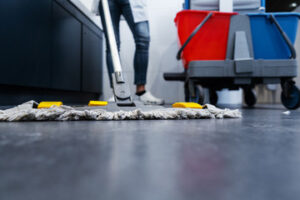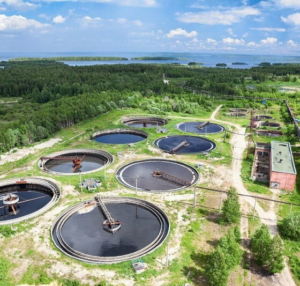Roof Cleaning Sarasota involves removing algae, mold, mildew, lichen and moss from roofs, as well as cleaning oxidation on metal roofs. This process also helps prevent pest infestations, which can degrade shingles and weaken the structure of your home.
The roof cleaning process begins with sweeping and blowing away loose debris like pine needles, branches and leaves that can trap moisture on the surface of the roof. Next, a soft wash is applied.

Bleach-based roof cleaners, like chlorine bleach, are the most commonly used roof cleaning chemicals by professional pressure washing contractors. These cleaners are diluted with water and applied with pressure washers to remove dirt, grime, mold, algae and other stains from the surface of shingles and concrete tiles. Many of these cleaning contractors call their cleaning method soft wash or low-pressure roof cleaning. The truth is that bleach is a harsh chemical that can cause damage to your home’s exterior if not properly used.
The main problem with using bleach as a roof cleaning chemical is that it can damage the shingles, killing the plant life and damaging the underlying structure of your roof. Additionally, it’s possible that bleach will only kill the surface growth of algae and moss, but fail to penetrate deeply enough to remove root structures. This is why it’s important to hire a professional roof cleaning contractor that uses cleaning solutions specifically designed to address your specific staining issue.
Another common roof cleaning chemical is potassium hydroxide. This is a powdered chemical that performs somewhat similar to sodium hypochlorite, but comes with its own set of problems. It is highly corrosive and can damage shingles, metal flashing, aluminum gutters, and other roofing materials. Additionally, it often produces a white haze that is nearly impossible to rinse off.
Finally, peroxide-based cleaners are also used as a roof cleaning solution. This is a great alternative to using chlorine bleach, and it can actually produce some amazing results. However, it’s important to remember that it is a bleaching agent and should only be used in the same situations where chlorinated bleach is.
Additionally, it’s important to be aware that using a peroxide cleaner may require special equipment and extra time to rinse the chemicals off the roof. It’s also essential to follow the same job preparations as you would with chlorine bleach, including pre-moistening the surface, diluting the chemical, and properly rinsing after the chemicals are applied.
Ammonia-Based Roof Cleaners
A number of different manufacturers produce chemical-based cleaners that eliminate molds, mildew, fungus, and algae. These formulas typically contain ammonia, copper sulfate, and trisodium phosphate, among other chemicals. Ammonia helps inhibit the growth of mildew and mold, while copper sulfate kills mosses and algae and also serves as an effective degreaser. The phosphates help to remove oily stains. They are less caustic than bleach and can be used on a variety of roof materials. They can also be used to clean gutters, siding, and walkways. Many of these cleaners are formulated to be safe for plants, although some caution should still be taken when using them around delicate plants.
If you’re concerned about the safety of these products for your plants and children, consider a nontoxic alternative such as the Spray and Forget Moss, Mildew, and Mold Stain Remover, which is safe to use on all types of roofing materials. It’s easy to apply and requires no scrubbing, and it produces minimal fumes. This product also works well on vinyl and aluminum gutters, as well as on other surfaces around your home.
Another choice is the Roof Cleaning, which is specifically formulated for metal roofs and cladding. It contains ammonia and should be diluted before application. It also contains emulsifiers that enable the removal of grease from metal. This is an excellent cleaner for galvanized metal roofing. It’s also effective at removing rust and dirt from zinc-coated roofs, enabling them to be repainted after cleaning.
Homemade cleaning solutions aren’t always safe for your roof and can actually harm it, especially if you choose to use high-strength chlorine bleach. The best option is to opt for an eco-friendly cleaning solution that doesn’t contain harmful chemicals, like a combination of household cleaners such as a quart of standard laundry bleach with a gallon of water and 1/4 cup of a non-ammonia heavy cleaner such as TSP or trisodium phosphate. Then spray the mixture and allow it to set for a few hours before rinsing it. This method is often called a soft wash, no-rinse, or drone chemical cleaning.
Copper Sulfate-Based Roof Cleaners
Many chemical roof cleaning products use a combination of chemicals including ammonia, copper sulfate and trisodium phosphate. They all act as powerful cleaning agents but some are too harsh for metal, such as copper, or other roofing materials such as asphalt shingles. They also often come with a strong odor that many find unpleasant. There are eco-friendly cleaners that offer the same power of chemical-based roof cleaners but without the harsh ingredients. One option is Wet and Forget, which is a moss, mildew and stain remover that works on most roofing materials. It’s easy to apply and doesn’t require scrubbing.
Other options include the copper-based ARREST’R, which is an algaecide that dramatically inhibits mold/mildew and comes with a 2-year warranty. It requires a yearly application, but it works well and is safe for most roofing materials. It can also be used for a variety of surface issues such as oily stains, rust and more.
Copper sulfate is a long-standing chemical that’s easily found on the internet in a powder form. It’s a common product used to clear drains of roots that are clogging septic systems and is a great choice for areas with high humidity, where fungus and lichens grow. It can be sprayed on a roof to help prevent buildup, or mixed with bleach to kill moss and then hosed off.
Choosing the best roof cleaning product for your home isn’t always easy, as each chemical addresses a different issue. For instance, bleach cleansers work great for dissolving tough stains and black streaks. But they might not be able to tackle the underlying problem of algae and mold. If you’re looking for an overall pressure cleanser, try Oxy Solve, which can be used on a variety of surfaces around the house. There are also specific stains that can’t be removed with bleach, such as grease stains and mineral deposits. In those cases, it might be better to turn to a specialty cleaner such as the Star Brite Mold and Mildew Stain Remover or the Simple Green Industrial Cleaner/Degreaser. These cleaners can be used to remove tough stains from asphalt and tile as well as most other surfaces.
Beach-Based Roof Cleaners
While bleach and chemical-based cleaners can be highly effective at removing stains, they may damage certain roofing materials such as shingles, tiles and wood. Additionally, high levels of pressure can strip granules from roof tiles and crack or break the surface of your roof. As a result, some HOAs do not permit the use of these types of cleaning chemicals on their properties.
These harsh cleaners also pose health hazards for those working on your roof. Not only can they be damaging to the skin, but they are also dangerous to birds, insects and other animals that may live in or near your home. In addition, they can also damage your lawn and garden if the cleaners get in or run off of your roof into vegetation.
Using bleach on your roof can also void your roof warranty, as it can cause discoloration, warping, and damage the underlying material of the roofing system. If you are looking for a less aggressive cleaning method that will still provide long-lasting results and prevent rapid recontamination, soft wash cleaning is the way to go.
Soft washing utilizes a combination of powerful, eco-friendly cleaning solutions and low-pressure water to remove harmful contaminates from your roof. These cleaning solutions kill mold, mildew, and algae while removing stains and other debris from your roof. These cleaning solutions then leave a growth-inhibiting residue that inhibits future contamination.
In contrast, traditional roof cleaning involves a high-pressure rinse and often requires multiple applications to be effective. This is due to the fact that traditional cleaners often do not contain enough concentration of cleaning solution to fully penetrate and loosen contaminates. In addition, traditional roof cleaning can also damage or strip granules from the surface of your roof, leading to premature roof wear and tear.
Regular roof cleaning is one of the best ways to protect your investment and add value to your property. However, you should always contact a professional who is licensed and experienced in roofing and knows the best cleaning methods for each type of roofing. A roofing contractor who specializes in stain prevention treatments like Roof-A-Cide can help you maintain the beauty and integrity of your roof for years to come.

